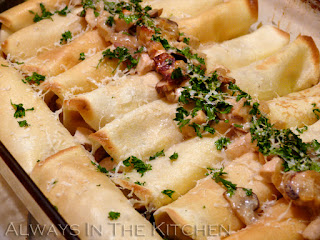
Yorkshire puddings are essentially a simple popover that has been flavoured with the drippings of the roast that they are made to accompany. They are airy, eggy, and made a perfect vessel to drunkenly cradle a gravy payload, half of which seeps slowly into the rest of your plate (and, if you're lucky), particularly your potatoes.
The batter is remarkably like crêpe batter. The only difference, really, is that instead of putting any fat in the batter, you place it in the cups of the popover/muffin tin before adding the batter. Well, and they're cooked in a very, very hot oven, as opposed to over a medium-ish flame on the stovetop. But enough about crêpes.
Yorkshire puddings are also somewhat terrifying for a lot of cooks - not because they're difficult, but because they require precise adherence to the rules, or they will come out as sad, dense little muffin-pucks. Some cooks claim that it's best to make the batter a bit ahead and let it rest - something about rehydrating the flour, I think - and I always do, simply for convenience. Here are the rules that make all the difference:
1) Preheat the empty popover or muffin tin. Preheat the hell out of it. I like to put mine into the oven 15 minutes before the roast is due to come out, and then leave it in when I crank the temperature up so that it will be ready to cook the popovers. That baby is hot! If you omit this step, all is lost. Have a dinner roll instead.
2) Preheat the fat. Once the roast is out of the oven, whether you are using roast drippings for a proper pud, or vegetable oil, or some leftover chicken fat that you've got stashed in the freezer (looks at ceiling, whistles to self), get the fat into the blazing hot pan...and put the pan back in the oven, for at least a few minutes, and put the overhead fan on high. If you omit this step, the pan and fat will not be hot enough, and all is lost. Have a dinner roll instead.
3) Add the batter quickly to the hot fat in the cups. Use a pouring jug with a spoon drip-catcher for maximum efficiency (actually, true maximum efficiency suggests that you would have your batter standing by in a squeeze bottle with a large bore opening, but unless you have such a pancake dispenser sort of setup, a jug with a lip (such as a big measuring cup) is your best bet). If you omit this step, the pan will cool down too much, and all is lost. Have a dinner roll instead.
4) Get the tin back into the oven pronto! Do not open the oven door until the puds are cooked - or at least 15 minutes have gone by. If you omit this step, all is lost. Have a dinner roll instead.
5) Marvel at how beautifully risen and crazy tall your popovers are, and serve right away.
A note about using vegetable oil instead of drippings or schmaltz - for the love of dinner, please use something with a really high smoke point, or you will fill your kitchen with acrid burnt-fat smell, and...and all is lost. Have a dinner roll instead.
So...here's the recipe. I really do measure the flour by weight, but if you don't, it's approximately a scant cup of sifted flour)
Yorkshire Puddings
Makes 12 regular-muffin sized
115 grams flour
3 eggs
285 mL 1% milk
1/8 teaspoon kosher salt
3 tablespoons fat (roast dripping, schmaltz, or high-smoke-point oil)
Whisk the eggs, flour, salt, and milk together until smooth to make your batter. Pour the batter into a jug, and let it sit for 30 minutes before you use it.
See the critical steps listed above, or this abbreviated version: Turn your oven up to 475F, and place a dry 12 cup muffin tray in the oven to heat up for at least 5 minutes (or however long it takes the oven to get up to that temperature).
Place 1 teaspoon of fat in each muffin hole, and put the tray back into the oven and heat until fat is very hot, at least another 5 minutes.
Extract the muffin tin and carefully (and quickly!) pour the batter into fat in the muffin cups - only half-fill each cup. This bit kind of looks gross, because the fat swirls all around the batter. That's fine; it's supposed to.
Close the door and cook for 15 minutes without opening the oven door, reduce heat to 350 F and bake for another 5 - 10 minutes, or until golden.

If you have leftover puds, try them for breakfast, gently re-heated and filled with jam, or cheese, or even scrambled eggs! If the exterior is a little squidgy from sitting overnight, blot well with paper towels before heating/filling. They lose their crispness, but they are still delicious.






























